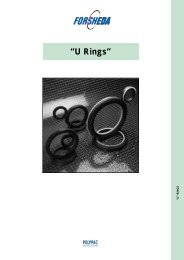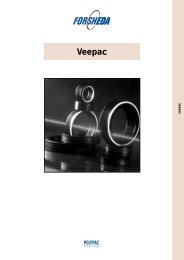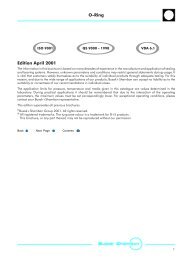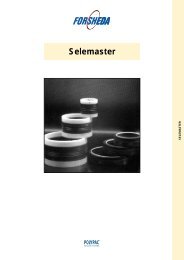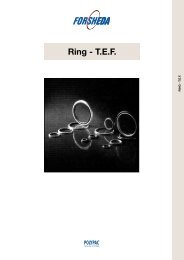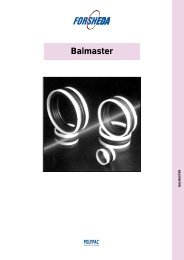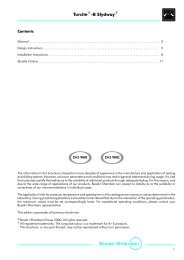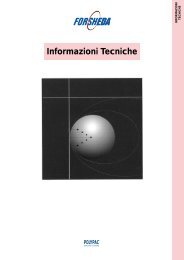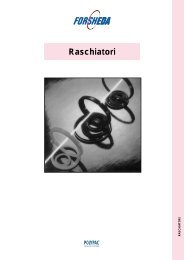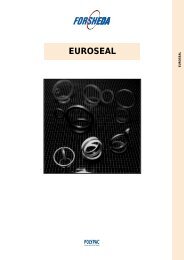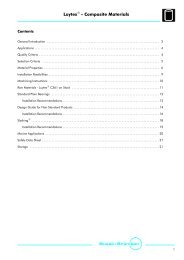Rotary Seals - Dilanda.it
Rotary Seals - Dilanda.it
Rotary Seals - Dilanda.it
You also want an ePaper? Increase the reach of your titles
YUMPU automatically turns print PDFs into web optimized ePapers that Google loves.
<strong>Rotary</strong> Seal<br />
Aggressive media:<br />
Generally aggressive media (e.g. solvents) have poor<br />
lubricating properties and therefore we recommend<br />
Turcon ® Varilip ® or PDR seals. Turcon ® and other PTFE<br />
materials solve the problem of chemical resistance and the<br />
metal cage can be produced out of various Stainless Steel<br />
materials. For further details on these products please refer<br />
to our separate catalogue on “PTFE <strong>Rotary</strong> Shaft <strong>Seals</strong>“<br />
Circumferential veloc<strong>it</strong>y<br />
The trend in the market shows an important increase of<br />
the circumferential veloc<strong>it</strong>y and therefore new heatresistant<br />
materials need to be developed.<br />
Veloc<strong>it</strong>y mainly influences the heat generation in the<br />
sealing gap and thus lim<strong>it</strong>s the use of the seal. The<br />
dissipation of the heat generated by the friction occurs via<br />
the media and the shaft <strong>it</strong>self. Depending on the capabil<strong>it</strong>y<br />
of the fluid to be sealed to convey the heat away from the<br />
sealing area, the circumferential veloc<strong>it</strong>y must be reduced<br />
accordingly e.g. in dry running cond<strong>it</strong>ions the heat<br />
generated in the sealing area can be 40 °C above the<br />
fluid temperature. In such cases we recommend to lim<strong>it</strong> the<br />
use in maximum environment temperature by the above<br />
value.<br />
In add<strong>it</strong>ion to the heat generation, the important cr<strong>it</strong>eria<br />
to be considered is the possible loss of contact of the<br />
sealing lip due to centrifugal forces. This applies to rotating<br />
seals w<strong>it</strong>h axial sealing lips e.g. V—Ring or GAMMA-seal.<br />
Veloc<strong>it</strong>y lim<strong>it</strong>s are specified in each individual chapter.<br />
Problems may also occur when radial lip seals are<br />
assembled into housings rotating at high angular veloc<strong>it</strong>y.<br />
Pressure<br />
<strong>Rotary</strong> seals often operate w<strong>it</strong>hout system pressure<br />
applied. Nevertheless the relative movements w<strong>it</strong>hin the<br />
equipment or heat generation can create pressure peaks<br />
generally lim<strong>it</strong>ed to 0.05 MPa.<br />
The pressure applied to the sealing lip increases the friction<br />
force and consequently the heat generation. Therefore the<br />
operating cond<strong>it</strong>ions need to be adapted/reduced<br />
accordingly. See recommendations in the corresponding<br />
chapters.<br />
Pressures up to 1MPa require e<strong>it</strong>her special back-up rings or<br />
special radial oil seal profiles. See selection Table II.<br />
<strong>Rotary</strong> joints are mainly dedicated to convey various fluids<br />
under high pressures up to 30 MPa and thus require<br />
Turcon ® based sealing elements e<strong>it</strong>her Turcon ® Roto Glyd<br />
Ring ® or Turcon ® Roto Variseal ® depending on the<br />
circumferential veloc<strong>it</strong>y. First selection can be made from<br />
the Table II.<br />
Pressure influences heavily the lubricating film in the<br />
contact area of the lip and consequently the heat<br />
generation. Therefore a reduction in circumferential<br />
veloc<strong>it</strong>y is required when pressure is applied to the<br />
sealing lip.<br />
Temperature<br />
Temperature is the most cr<strong>it</strong>ical cr<strong>it</strong>eria to be considered<br />
when selecting a rotary seal.<br />
The temperature lim<strong>it</strong>s indicated in the selection tables are<br />
maximum operating temperatures of the sealing material<br />
in fluids for which the material compatibil<strong>it</strong>y is secured<br />
(good chemical resistance and controlled swelling/<br />
shrinkage).<br />
The above descriptions show that the temperature in the<br />
sealing area is influenced by various parameters especially:<br />
- The lubricating capabil<strong>it</strong>y of the fluid and <strong>it</strong>s abil<strong>it</strong>y to<br />
dissipate the heat generated under the sealing lip.<br />
- The circumferential veloc<strong>it</strong>y<br />
- The pressure applied<br />
The resulting temperature in the sealing area must be<br />
considered to select the appropriate material. The in<strong>it</strong>ial<br />
temperature of the fluid can increase by up to 50%<br />
depending on the above operating parameters. For all<br />
applications please refer to the recommendations in the<br />
various chapters and don’t hes<strong>it</strong>ate to contact your local<br />
Busak+Shamban company if any doubt remains.<br />
Hardware<br />
In all chapters the hardware parameters are described in<br />
relation to the profile and material types.<br />
Nevertheless one general rule is valid for all rotary seals:<br />
the mating surface (shaft surface) must be free of spiral<br />
grinding marks as they may cause pumping effects and<br />
leakage. Plunge grinding is to be the preferred machining<br />
method for the shaft.<br />
Wear on the shaft in the contact area of the sealing lip is<br />
the most frequent failure mode the shaft seal users can<br />
meet w<strong>it</strong>h. It is mainly the result of unexpected metal<br />
particles carried by the fluid to the sealing lip. The particles<br />
are embedded in elastomer materials that act as a<br />
millstone and grind grooves into the shaft. To avoid such<br />
failure modes e<strong>it</strong>her particles must be kept away from the<br />
sealing lip or the surface roughness must be adjusted to be<br />
able to accommodate them. Therefore <strong>it</strong> requires high<br />
surface hardness. Busak+Shamban recommend a minimum<br />
hardness of 55 HRC on minimum 0.3 mm depth. Other<br />
material combinations are possible depending on the<br />
contamination in the system. See recommendations in<br />
the chapter “Environment“.<br />
10<br />
Latest information available at www.busakshamban.com<br />
Ed<strong>it</strong>ion April 2006



